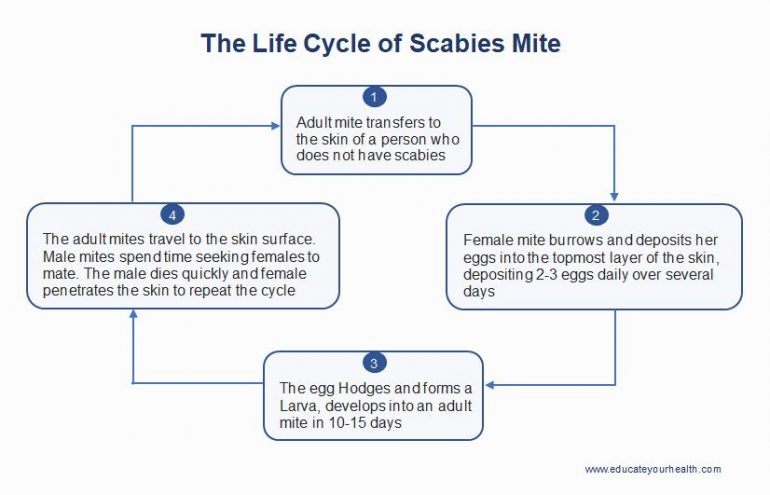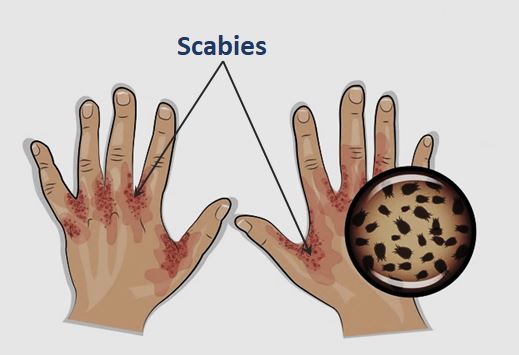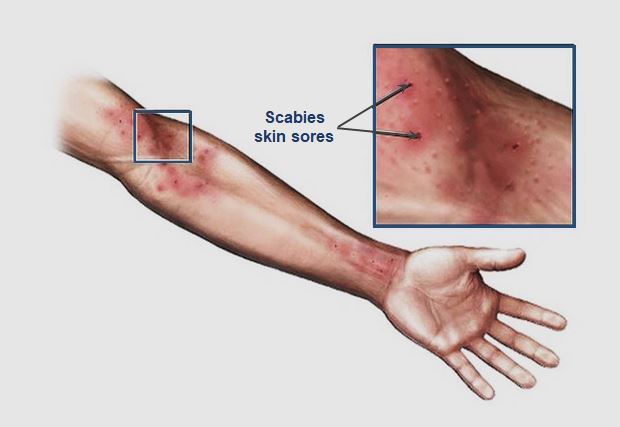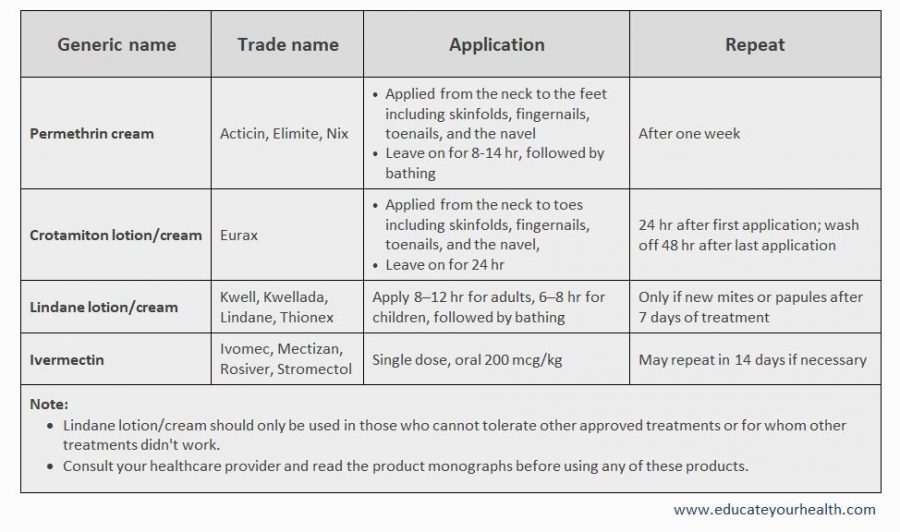Definition and Causes:
DEFINITION:
Scabies is a contagious and a very itchy skin condition caused by tiny mites, that burrow under the surface of the skin. The infestation causes intense itching, develops due to a hypersensitive reaction to the mite, its eggs or its feces. These mites are called Sarcoptes scabiei.
CAUSES:
Scabies occurs worldwide and can affect people from all socioeconomic levels and can spread rapidly in crowded areas where there is close body contact is between people, such as in hospitals, nursing homes, school class, child-care facilities, and prisons.
It usually takes about 10-15 days after skin exposure to scabies before the infected person develops symptoms. During that time the infected person can unknowingly spread scabies to others. These mites can live on a variety of surfaces and transmission can also occur via prolonged contact with towels, bedding, clothing, and other fabrics from infested people. However, once away from the human body, mites do not live very long and usually only able to survive 2-3 days at room temperature.

Symptoms:
Scabies signs and symptoms include:
- Itching, often intense and usually worse at night
- Tiny, thin, irregular burrow on the skin
Common places where symptoms are more likely to occur:
- Between the fingers
- Underarms
- Around the waistline
- Along the palm side of the wrists
- On the inner elbows
- Shoulder blades
- On the buttocks and knees
- On the soles of the feet
- Around the breasts
- Around the male genital area
In infants and very young children, scabies may also appear on
- Scalp
- Face
- Neck
- Palms and soles
Itching can cause skin damage and small wounds (skin excoriation), at that point then become infected with bacteria leading to further skin damage, ulcers, and risk of abscesses.


Investigations and Treatment:
INVESTIGATION:
Scabies infection is usually diagnosed based on the patient’s reports of itching, as well as the appearance and distribution of the rash and the presence of burrows on the skin. However, there are some tests that could be used to help confirm the presence of scabies including:
- Microscopic exam of scrapings from suspicious lesions
- Burrow Ink Test (BIT)
- Topical tetracycline solution
- Shave biopsy
- Needle extraction of mites
TREATMENT:
Scabies can spread easily and quickly among individuals. Hence, once diagnosed, it is important to treat all household contacts at the same time even if some individuals within the household asymptomatic as during the early stage of new infestation most individuals so no symptoms. Simultaneously treating all household contact, helps to avoid reinfestation and transmission. Clean clothing should be worn after treatment.
After treatment, the burrows that were on the body before treatment will remain for a few weeks however, no new burrows or rashes should appear 24-48 hours after effective treatment. Skin rashes and itching usually begin to subside within one to two days, but may continue for up to 3-4 weeks after treatment. Non-drowsy antihistamines, such as loratadine (Claritin) or cetirizine (Zyrtec) reduce itching. Benadryl (diphenhydramine) is an antihistamine that can also be used but can cause drowsiness. Steroid cream or a course of steroid pills may be recommended if itching is severe.
Consult your doctor or pharmacist regarding treatment, especially for children and pregnant/nursing women, or individuals with any underlying serious medical conditions. Follow-up with your healthcare provider if symptoms persist or become worse or new skin burrows/lesions appear, as this may be a sign that repeat or further treatment may be required.
Medications commonly prescribed for scabies include:

Usually, the mites are able to survive 2-3 days away from human skin at room temperatures. To make sure that all the scabies mites are killed, all bed linen (sheets, pillowcases, blankets), clothes towels and stuffed animals used in anytime during the 3 days before treatment started by infested persons or their household, sexual, and close contacts anytime during the three days before treatment should be laundered using hot water and a hot dryer for at least 20-30 minutes, or by sealing in a plastic bag for at least 72 hours if hot water is not available. Another option is to dry-clean these items or by sealing in a plastic bag for at least 72 hours. All non-washable items (e.g. stuffed toys) should be sealed in a plastic bag for 3-4 days. Clean and carefully vacuum the room(s) and any mattresses used by the infected person.
A child may return to school/day nursery the day after completing their initial treatment series.
Risk Factors and Prevention:
RISK FACTORS:
- Children younger than 15 years and adults older than 65 years of age
- Sexual contact with new or multiple partners
- Presence of many children in the household
- Close, physical contact with a person who has scabies
- Poor housing
- A weakened immune system
- Sharing clothes and towels
- Close contact with an animal with scabies
PREVENTION:
- Use hot, soapy water to wash all clothing, towels and bedding used within three days before beginning treatment. Dry with high heat
- Dry-clean items you can’t wash at home
- Items that cannot be washed should be sealed and stored in a sealed plastic bag for at least one week
- Thoroughly vacuum any carpet or upholstered furniture, dispose of vacuum bag afterwards
- Clean all clothes and linen
- Avoid sharing clothes or towels
- If your child goes to sleepover parties, provide a sleeping bag, pillow and blanket from home
- Practice good hand hygiene
- Try to avoid contact for several days with hard-to-clean or non-cleanable items
- Abstain from intimate or sexual contact until treatment is successful
- Infested individuals should be excluded from normal activities (day care, school, work) until 24 hours after completed treatment
Outcome:
Scabies is not life-threatening and proper treatment can get rid of the mites and eliminate symptoms such as itch.








